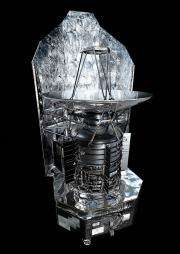Seeing the Invisible

(PhysOrg.com) -- Astronomers, like physicians, use as much of the electromagnetic spectrum as they can, from X-ray to radio wavelengths, to examine their subjects the with the most suitable diagnostics.
For astronomers, different wavelengths typically reveal different temperature environments, for example, or different conditions of matter, while some wavelengths can probe regions that are impenetrable to other wavelengths. One span of the spectrum of particular interest to astronomers is the four octaves of infrared light from the short infrared band (just adjacent to the visible) to the submillimeter. It is precisely in this span that a large fraction of the universe emits most of its radiation - the reason being that ubiquitous, cool dust absorbs starlight and many other kinds of radiation from sources and reradiates it here, in this far-infrared band. The band also contains the diagnostic lines of important molecules like water - but precisely this latter feature means that nearly the entire range is blocked from view by the earth’s molecule-rich atmosphere.
Several satellite observatories over the past few decades have successfully begun to reveal the universe in this mysterious range, but until now none has had the large collecting area, complete wavelength coverage, sensitivity, or both imaging and spectral capacity to settle questions that have remained unanswered since the infrared sky was first glimpsed in the 1960’s. For example: How do stars begin to form during the earliest phases of their birth in frigid clouds of gas and dust? Is it actually the case that the peak of the energy output of bright galaxies is at far-infrared wavelengths, and precisely how much energy is radiated? How does this value change as the universe evolves or as galaxies mature? Are water and molecular oxygen as abundant as we suspect from earlier sightings, or have they perhaps frozen into ices or been destroyed?
One year ago, the European Space Agency partnered with NASA and launched the Herschel Space Observatory, a 3.5-meter, cryogenically cooled telescope with sensitive cameras and spectrometers that cover the full electromagnetic band from the far infrared to the submillimeter.
This week the journal Astronomy and Astrophysics accepted for publication an entire issue's worth of papers with the first dramatic results from Herschel. CfA astronomers Joe Hora, Tim van Kampen, Eric Keto, Gary Melnick,. Phil Myers, Tom Robitaille, Howard Smith, Tony Stark, Volker Tolls, and Qizhou Zhang were co-authors on about ten papers that presented discoveries both in our Milky Way and in external galaxies.
The extragalactic results can be illustrated by a set of papers on the luminous galaxy Mrk 231. They reveal for the first time the presence of an abundance of warm molecular CO and water, gas that appears to have been heated in part by X-rays originating from around the galaxy’s massive black hole. Moreover, the scientists find that while the bright dust emission does indeed reach its peak in the far infrared, at the longest wavelengths the emission is not characteristic of typical dust. Future papers will investigate these findings in more detail and compare Mrk 231 with other galaxies, but the initial results show that the unseen universe has a rich story to tell now that it is no longer hidden from view.
Provided by Harvard-Smithsonian Center for Astrophysics




















